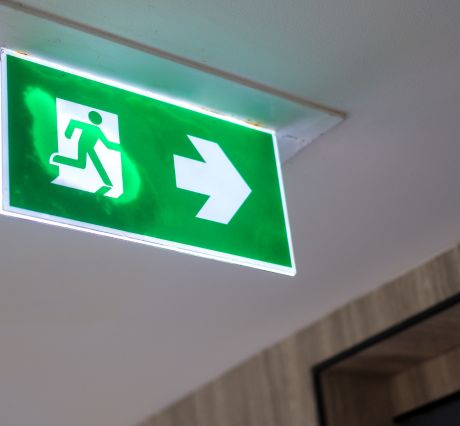Your Guide to Emergency Lighting Installation
Are you looking into Emergency Lighting Installation but not sure where to start or why you might need it?
Emergency situations can arise unexpectedly, posing significant risks to human life and property.
In the United Kingdom, stringent regulations are in place to safeguard against such risks and ensure the safety of individuals within various premises.
One crucial aspect of these safety measures is emergency lighting installation. In this article, we delve into the importance of emergency lighting, the regulations governing its installation, and the key considerations for effective implementation.
The Significance of Emergency Lighting:
Emergency lighting serves as a critical component of a building’s safety infrastructure.
It ensures that in the event of a power failure or any other situation that leads to reduced visibility, individuals can safely navigate their way out of a building.
The provision of adequate emergency lighting helps prevent panic, reduces the risk of accidents, and facilitates the efficient evacuation of occupants. It’s not just about meeting regulations; it’s about preserving lives.
Regulations and Standards:
In the UK, emergency lighting installations are governed by a set of stringent regulations to ensure consistency and reliability across different premises. The key regulatory documents include:
- BS 5266-1:2016 – Code of Practice for the Emergency Lighting of Premises: This standard provides comprehensive guidance on emergency lighting systems, covering various aspects such as design, installation, testing, and maintenance. It’s a fundamental resource for professionals involved in emergency lighting implementation.
- The Regulatory Reform (Fire Safety) Order 2005: This order places a legal obligation on the ‘responsible person’ for a non-domestic premises to ensure the safety of occupants in case of fire, which includes the provision of appropriate emergency lighting. It emphasizes the importance of conducting regular risk assessments and taking necessary measures to mitigate fire-related risks.
- Building Regulations – Part B (Fire Safety): This section of the Building Regulations outlines requirements for fire safety within buildings. It details the standards that must be met concerning means of escape, including emergency lighting, to enhance the chances of safe evacuation during emergencies.
Key Considerations for Effective Emergency Lighting Installation:
Installing emergency lighting is not a mere compliance exercise; it requires careful planning and execution to ensure optimal functionality. Here are some essential considerations for effective emergency lighting installation:
- Risk Assessment: Conducting a thorough risk assessment is the foundation of any emergency lighting installation. This assessment helps identify potential hazards, escape routes, and high-risk areas that require enhanced lighting coverage. By understanding the specific needs of the premises, an appropriate emergency lighting system can be designed and implemented.
- Emergency Lighting Types: Different types of emergency lighting serve different purposes. These include escape route lighting, open area lighting, high-risk task area lighting, and standby lighting. Each type has a specific function and placement requirement, all of which need to be carefully evaluated during the installation process.
- Placement and Coverage: The strategic placement of emergency lighting units is crucial to ensure proper coverage and visibility. Escape routes, exit doors, staircases, and changes in floor level must be adequately illuminated. Moreover, lighting units should be spaced in a way that eliminates dark spots and ensures seamless movement during evacuation.
- Duration and Power Source: Emergency lighting systems are designed to operate during power outages, making the choice of power source and duration of operation essential. Battery-backed systems are commonly used to provide illumination for a specific duration. Regular testing and maintenance of batteries are critical to ensure their reliability when needed.
- Testing and Maintenance: Regular testing and maintenance are vital to keep emergency lighting systems in optimal working condition. Systems should be tested periodically to ensure that all components, including batteries and bulbs, are functioning correctly. Any issues should be promptly addressed to maintain the system’s reliability.
Emergency lighting – the final decision
Emergency lighting installation is a fundamental aspect of ensuring safety in the UK’s diverse range of buildings and premises. The comprehensive regulations and standards in place emphasize the importance of proper planning, installation, and maintenance.
By adhering to these guidelines and considering the key factors discussed in this article, stakeholders can contribute to creating safer environments and enhancing the well-being of occupants.
In times of crisis, effective emergency lighting can make a significant difference, transforming potential chaos into orderly and secure evacuations.
If you’d like to discuss your emergency lighting installation needs or need help understanding the regulations the give us a call today.








